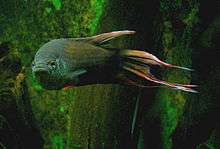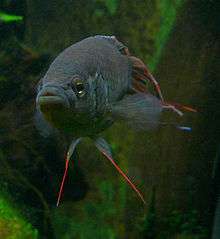Red-backed paradise fish
| Red-backed paradise fish | |
|---|---|
 | |
| Male | |
| Scientific classification | |
| Kingdom: | Animalia |
| Phylum: | Chordata |
| Subphylum: | Vertebrata |
| Infraphylum: | Gnathostomata |
| Superclass: | Osteichthyes |
| Class: | Actinopterygii |
| Subclass: | Neopterygii |
| Infraclass: | Teleostei |
| Superorder: | Acanthopterygii |
| Order: | Perciformes |
| Suborder: | Anabantoidei |
| Family: | Osphronemidae |
| Subfamily: | Macropodusinae |
| Genus: | Macropodus |
| Species: | M. erythropterus |
| Binomial name | |
| Macropodus erythropterus Freyhof & Herder, 2002 | |
The red-backed paradise fish (Macropodus erythropterus) is a species of gourami endemic to Vietnam. It inhabits hill streams with overhanging vegetation and underwater roots. This species grows to a length of 6.5 cm (2.6 in).[2]
Species
The red-backed paradise fish is generally indigenous to freshwater lakes and rivers in and around China and Asia. More specifically, the red-backed paradise fish is prominently found in the Cam Lo River (Giang drainage), in Central Vietnam[3]. The fish generally is palegic, meaning that it lives in the palegic water regions of deep fresh water lakes in China and Asia. The pelagic zone occupies 1,330 million km3 (320 million mi3) with a mean depth of 3.68 km (2.29 mi) and maximum depth of 11 km (6.8 mi). [4][5][6]
Habitat
The habitat of the Macropodus erythropterus is of calm waters. They usually reside in places where the water is not rough such as in streams. Also, the streams they were found in were typically near hills. They like to remain close to the shore. The red-backed paradise often hangs near plant life. They are usually found where there are overhanging shrubs and much vegetation. Macropodus erythropterus is a freshwater fish. The red-backed paradise fish is also not marine. [7]
Internal Anatomy
The Gills: Used for breathing under water it consist of small fragment attach to the bony gill arch located just below the eyes. The Blood: Like humans, fish blood contain red blood cells and white bloods cells. However; their red blood cells contain nuclei (a mass of nerve cells in which fibers form connections). These types of cells direct their growth, metabolism, reproductive functions, and also transmits their genic characters. The Brain: All sensory information is processed here such as the higher behaviors (processing of what to eat do or react). The brain also commands the respiratory system differencing when the fish is above or below water. [9]
Aquarium
A reasonable tank should measure at least 30″ x 15″ x 12″/75 cm x 37.5 cm x 30 cm/88.5 liters. The necessities of the tank should include clumps of plant species, floating vegetation, and a dark substrate. Because the fish is from sluggish waters, filtration should not be too strong: an air-powered sponge filter or a power filter at its lowest setting. Within the tank, the water temperature must be kept in cool in the range 59 – 72 °F/15 – 22 °C because the fish become more susceptible to disease if maintained at higher temperatures for prolonged periods. For these fish, an "overwintering" period of several months are maintained at low temperatures of 50 – 54 °F/10 – 12 °C provides long-term health. [9]
References
- ↑ Huckstorf, V. 2012. Macropodus erythropterus. In: IUCN 2013. IUCN Red List of Threatened Species. Version 2013.2. <www.iucnredlist.org>. Downloaded on 24 March 2014.
- ↑ Froese, Rainer and Pauly, Daniel, eds. (2014). "Macropodus erythropterus" in FishBase. February 2014 version.


[3] Winstanley, Tom, and KENDALL D. Clements. "Morphological re-examination and taxonomy of the genus Macropodus (Perciformes, Osphronemidae)." Zootaxa 19.8 (2008): 1-27.
[4] Costello MJ, Cheung A and De Hauwere N (2010) "Surface Area and the Seabed Area, Volume, Depth, Slope, a4d Topographic Variation for the World’s Seas, Oceans, and Countries" Environ. Sci. Technol. 44(23): 8821–8828. doi:10.1021/es1012752
[5] Charette MA and Smith WHF (2010) "The volume of Earth's ocean" Oceanography, 23(2): 112–114.
[6] Ocean's Depth and Volume Revealed OurAmazingPlanet, 19 May 2010.
[7] Huckstorf, V. 2012. Macropodus erythropterus. The IUCN Red List of Threatened Species. Version 2014.3. <www.iucnredlist.org>. Downloaded on 30 January 2015
[8] http://www.freshwater-aquarium-guide.com/Fish-Anatomy1.htm Web, access 20153101
[9] Macropodus Ocellatus Roundtail Paradise Fish. Retrieved January 30, 2015, from http://www.seriouslyfish.com/species/macropodus-ocellatus/
